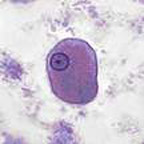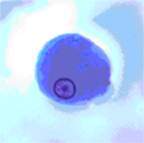

A patient is diagnosed as having diarrhea and specimens are submitted to the laboratory. When examining the permanent stained smears, the following images are seen. The test result is reported as follows: "Entamoeba histolytica trophozoites present." Based on the diagnosis of diarrhea and the laboratory findings, how would you identify the following objects seen in the permanent stained smears? Was the report correct as submitted to the physician? Why or why not?


These protozoan trophozoites measure approximately 17 µm long. The one on the right is stained with trichrome; the one on the left is stained with iron hematoxylin.
Scroll Down for Answer and Discussion
Answer and Discussion of Quiz #1
The images presented in the Quiz #1 were trophozoites of Entamoeba histolytica/E. dispar; thus the physician's report (Entamoeba histolytica trophozoites present) was incorrect. You will notice that the amebic trophozoites did not contain any ingested red blood cells (RBCs) within the cytoplasm. If no RBCs are seen in the cytoplasm and the trophozoites measure greater than or equal to 12µm, Entamoeba histolytica (true pathogen) cannot be differentiated from nonpathogenic Entamoeba dispar. Currently, there are immunoassays available that will confirm the presence of organisms in the Entamoeba histolytica/E. dispar group, as well as one immunoassay that will confirm the presence of the pathogen E. histolytica.
Note that the two images seen below are trophozoites of Entamoeba histolytica, the true pathogen; this identification is confirmed by the presence of ingested RBCs within the organism cytoplasm.
The correct laboratory report for the organisms seen in Quiz #1 would have been: Entamoeba histolytica/E. dispar trophozoites present. A computer comment could be added as follows: "Based on organism morphology, the presence of the true pathogen, Entamoeba histolytica (cause of amebiasis) could not be confirmed."
If your laboratory offers the immunoassay specific for Entamoeba histolytica, the computer comment could be: "If you want confirmation of the presence of Entamoeba histolytica, submit a fresh stool." Note: the immunoassays for Entamoeba histolytica or the Entamoeba histolytica/E. dispar group require fresh or frozen stools; formalinized specimens are not acceptable for testing.
Review
(Consistent with CAP Inspection Checklist): Every stool submitted for an O&P examination must be examined using the concentration and permanent stained smear procedures.
O&P Exam (Fresh Stool Specimen/liquid and/or very soft): Direct wet smear, concentration, permanent stained smear.
O&P Exam (Fresh Stool Specimen/formed stool): Concentration, permanent stained smear.
O&P Exam (Preserved Stool Specimen): Concentration, permanent stained smear.
Remember that all intestinal protozoan infections can be missed if the concentration ONLY is performed. The permanent stained smear is much more sensitive than the concentration alone. To date, there are no commercial immunoassay products available for the confirmation of infection with Dientamoeba fragilis; however, tests are under development for D. fragilis and Blastocystis spp.
Additional Reading:
Each Quiz has a two section format: the first section will present the Quiz topic and the second section will provide a discussion of the answer and/or various options in response to the Quiz situation presented to the user. In some situations, there may be more than one correct response.
The content within this site is made possible through the extensive contribution of Lynne S. Garcia, M.S., MT(ASCP), CLS(NCA), BLM(AAB), F(AAM), Director, Consultantation and Training Services (Diagnostic Medical Parasitology and Health Care Administration). For additional information, she can be contacted at LynneGarcia2@verizon.net.
Reference: Garcia, L.S. 2015. Diagnostic Medical Parasitology, 6th Ed., ASM Press, Washington, D.C.